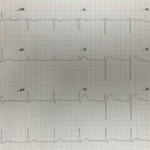OMI: STEMI & Beyond
Latest
Differential Diagnoses: diffuse ST segment elevation with a focus on left ventricular (LV) aneurysm
HPI: An elderly gentleman presents to the ED with diarrhea. He has no chest pain or dyspnea, and denies nausea or vomiting. He appears well. The following ECG was obtained…
STAT ECG Diagnoses: “Shark fin STEMI” morphology and what this ECG pattern means!
HPI: A 59-year-old male presents to the ED with exertional chest pain that resolved on arrival. An ECG (#1) is obtained at triage. While being interviewed by the physician who…
ECG Basics & Fundamentals: how frequently should you obtain serial ECGs in patients with concern for ACS
HPI: A 65-year-old patient is brought in by EMS for a chest pain history that is concerning for ACS. The following ECG is obtained: Case ECG Before watching this week’s…
ECG Basics & Fundamentals: serial ECGs in a patient with chest pain and a paced rhythm
HPI: A 63-year-old male calls EMS after a syncopal episode. He is found to be alert, but complaining of chest pain that radiates bilaterally and that is associated with diaphoresis….
Literature Review: outcomes for patients with STEMI presenting with nondiagnostic initial ECGs
A 45-year-old man presents to the ED with 1 hour of chest pain, shortness of breath, and diaphoresis. The following ECG is obtained:
Literature Review: what do you do when ST-segment elevation in STEMI resolves before cath lab activation
A 49-year-old man presents with chest pain and diaphoresis while riding his bike. His ECG shows inferior and posterior STEMI. After aspirin and nitroglycerin, the patient’s symptoms resolve and the…
STAT ECG Diagnoses: new T wave inversion or ST segment depression in aVL
A 66-year-old man presents to the ED with retrosternal chest pain that is associated with nausea. The following ECG is obtained:
Differential Diagnoses: over 15 causes of ST segment elevation…there is much more than STEMI
A 78-year-old woman with Alzheimer’s disease presents to the ED with dehydration and failure to thrive. She denies pain, diaphoresis, or dyspnea. The following ECG is obtained:
STAT ECG Diagnoses: the most commonly missed STEMI does not have ST segment elevation
A 70-year-old man presents to the ED with radiating chest tightness, nausea, and diaphoresis. The following ECG is obtained:
STAT ECG Diagnoses: considerations in hypotensive STEMI patients
A 72-year-old woman presents to the ED by EMS with chest pain. She was noted to have normal vital signs and an unremarkable physical exam and given aspirin and nitroglycerin…
Age as a cardiac risk factor
A 32-year-old woman presents to the ED with 2 hours of chest pain. She has a history of psychosis and smokes cigarettes. The following ECG is obtained:
ECG Basics & Fundamentals: dynamic ischemic ECG changes in ACS
A 41-year-old male with no past medical history is brought into the ED with bilateral shoulder pain that has been intermittent throughout the day. On arrival the pain is mild,…
STAT ECG Diagnoses: a peculiar pattern of ST segment elevation that is high risk for death!
A 64-year-old man with HTN and DM presents to the ED with chest pain that radiates to the right lower neck x 1 week. He also reports difficulty walking and…
Literature Review: which patients should go to the cath lab for reperfusion emergently? (Part 3/3)
HPI: A 60-year-old male with a history of CAD with a pacemaker presents to the ED with acute chest pain that radiates to the left arm. Pain is worse with…
ECG Basics & Fundamentals: you don’t always need ST segment elevation to benefit from acute reperfusion therapy
HPI: A 75-year-old male with a history of hypertension presents to the ED with substernal chest pressure. There is no associated diaphoresis or nausea. The following ECG was obtained. Case…
Literature Review: how does basic life support compare to advanced (ACLS) in out of hospital cardiac arrest outcomes, and does availability of prior ECGs improve accuracy of STEMI recognition by paramedics?
Before watching this video, ask yourself these questions: Is noninvasive therapeutic hypothermia safe and efficient? Does availability of a prior ECG improve accuracy of STEMI recognition by paramedics? How does…
Literature Review: ECG computer interpretations and review of STEMI criteria
HPI: A 45-year-old male is en route to your hospital by EMS with chest pain. EMS has transmitted this ECG to you from the field, with suspicion of STEMI. Case ECG…
ECG basics and fundamentals: Prehospital STEMI activations with a review of the literature
50-year-old woman with a PMHx of DM and obesity presents with dizziness and sub-acute back pain. She also reports myalgias and anorexia. She denies any associated chest pain, and is…
ECG Basics & Fundamentals: A stepwise approach to ECG interpretation in patients with chest pain and clinical concern for an acute coronary syndrome (ACS) with pearls and pitfalls in obtaining chest pain histories
HPI: 61 year old male with significant cardiac risk factors presents with chest pain that that radiates down both arms. The pain is exertional and improves with rest. His pain…
Free Content
Jump on our email list for free tips and insights delivered to your inbox monthly. No spam - just quick pearls and ECG education.
Categories
- No categories






















